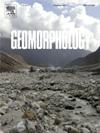The collapse of recently constructed risers of forest bench terraces and its mitigation
IF 3.1
2区 地球科学
Q2 GEOGRAPHY, PHYSICAL
引用次数: 0
Abstract
Bench terracing has become a common practice in north-central Portugal to establish eucalypt plantations on steep hillslopes. While terraces are typically considered to be a soil conservation technique, their construction with bulldozers, and without stone walls, may foster adverse effects on soil mobilization through the collapse of risers. Terracing removes all topsoil vegetation and the former tree roots, leaving the soil unprotected. Additionally, the bulldozers exert mechanical forces that cause the ground to break, mix, and/or shake, detaching soil particles. This affects soil structure and stability, leaving the soil without protection against erosion during rainfall events. The collapse of forest terrace risers, however, is poorly studied, and the same is true for the effectiveness of possible mitigation measures such as anionic polyacrylamide (PAM) and hydromulch, which have been found to be effective in stabilizing roadside risers. The present study aimed to quantify: (i) the collapse of bench-terrace risers during the first year following their construction; and (ii) the effectiveness of PAM and hydromulch in reducing this collapse.
The results revealed considerable soil mobilization from the terrace riser during the first post-terracing year, with the median deposition of sediments at the base of the risers being 258 Mg ha−1. In addition, landslides affecting risers from top to base were frequently observed. Both hydromulch and PAM were effective in reducing the cumulative annual deposition, to averages of 113 and 105 Mg ha−1, respectively. However, neither measure prevented the occurrence of landslides on parts of the risers.

求助全文
约1分钟内获得全文
求助全文
来源期刊

Geomorphology
地学-地球科学综合
CiteScore
8.00
自引率
10.30%
发文量
309
审稿时长
3.4 months
期刊介绍:
Our journal''s scope includes geomorphic themes of: tectonics and regional structure; glacial processes and landforms; fluvial sequences, Quaternary environmental change and dating; fluvial processes and landforms; mass movement, slopes and periglacial processes; hillslopes and soil erosion; weathering, karst and soils; aeolian processes and landforms, coastal dunes and arid environments; coastal and marine processes, estuaries and lakes; modelling, theoretical and quantitative geomorphology; DEM, GIS and remote sensing methods and applications; hazards, applied and planetary geomorphology; and volcanics.
 求助内容:
求助内容: 应助结果提醒方式:
应助结果提醒方式:


